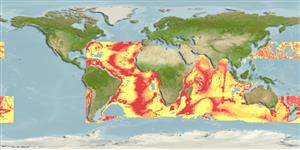>
Beryciformes (Sawbellies) >
Stephanoberycidae (Pricklefishes)
Etymology: Acanthochaenus: Greek, akantha = thorn + Greek, chaino = with the mouth opened (Ref. 45335).
Eponymy: Professor Christian Frederik Lütken (1827–1901) was a Danish naturalist, specialising in marine zoology. [...] (Ref. 128868), visit book page.
More on author: Gill.
Environment: milieu / climate zone / Tiefenbereich / distribution range
Ökologie
seewasser benthopelagisch; tiefenbereich 1655 - 5397 m (Ref. 58018). Deep-water; 40°N - 57°S, 77°W - 164°W
Atlantic, Indian and Pacific: in subtropical and temperate waters (Ref. 50895). In the Indian Ocean known localities include the Madagascar Ridge (Ref. 51654) and the West Australian Ridge, Naturalist Plateau.
Length at first maturity / Size / Gewicht / Alter
Geschlechtsreife: Lm ?, range 12 - ? cm
Max length : 15.2 cm TL Männchen/unbestimmt; (Ref. 41039)
Rückenflossenstacheln (insgesamt) : 0; Rückenflossenweichstrahlen (insgesamt) : 11; Afterflossenstacheln: 1; Afterflossenweichstrahlen: 9 - 10. Body scales are spiny (Ref. 37108). Body elongated, almost cylindrical, somewhat compressed (Ref. 10920). The snout protrudes forward above upper jaw, its length 3.4-4.4 times in head length, eyes fairly small, upper jaw extends beyond the posterior border of the eye. Dorsal and anal fins are opposite one another (Ref. 10920).
Body shape (shape guide): fusiform / normal.
Adults probably benthopelagic (Ref. 51654). Larvae taken at 30 m (Ref. 51654). Benthic crabs Malacostraca were found in the stomachs of 3 specimens SL 8.5-9 cm from Madagascar Ridge (Ref. 10920).
Life cycle and mating behavior
Geschlechtsreife | Fortpflanzung | Ablaichen | Eier | Fecundity | Larven
Maul, G.E., 1990. Stephanoberycidae. p. 611. In J.C. Quero, J.C. Hureau, C. Karrer, A. Post and L. Saldanha (eds.) Check-list of the fishes of the eastern tropical Atlantic (CLOFETA). JNICT, Lisbon; SEI, Paris; and UNESCO, Paris. Vol. 2. (Ref. 6535)
IUCN Rote Liste Status (Ref. 130435: Version 2025-1)
Bedrohung für Menschen
Harmless
Nutzung durch Menschen
Fischereien: nicht kommerziell
Tools
Zusatzinformationen
Download XML
Internet Quellen
Estimates based on models
Preferred temperature (Ref.
123201): 1.4 - 3.2, mean 2 °C (based on 3882 cells).
Phylogenetic diversity index (Ref.
82804): PD
50 = 1.0625 [Uniqueness, from 0.5 = low to 2.0 = high].
Bayesian length-weight: a=0.01122 (0.00514 - 0.02450), b=3.04 (2.87 - 3.21), in cm total length, based on all LWR estimates for this body shape (Ref.
93245).
Trophic level (Ref.
69278): 3.5 ±0.60 se; based on food items.
Generation time: 2.7 ( na - na) years. Estimated as median ln(3)/K based on 1
growth studies.
Widerstandsfähigkeit (Ref.
120179): mittel, Verdopplung der Population dauert 1,4 - 4,4 Jahre. (Assuming tmax > 3; K=0.41).
Fishing Vulnerability (Ref.
59153): Low to moderate vulnerability (29 of 100).
🛈
